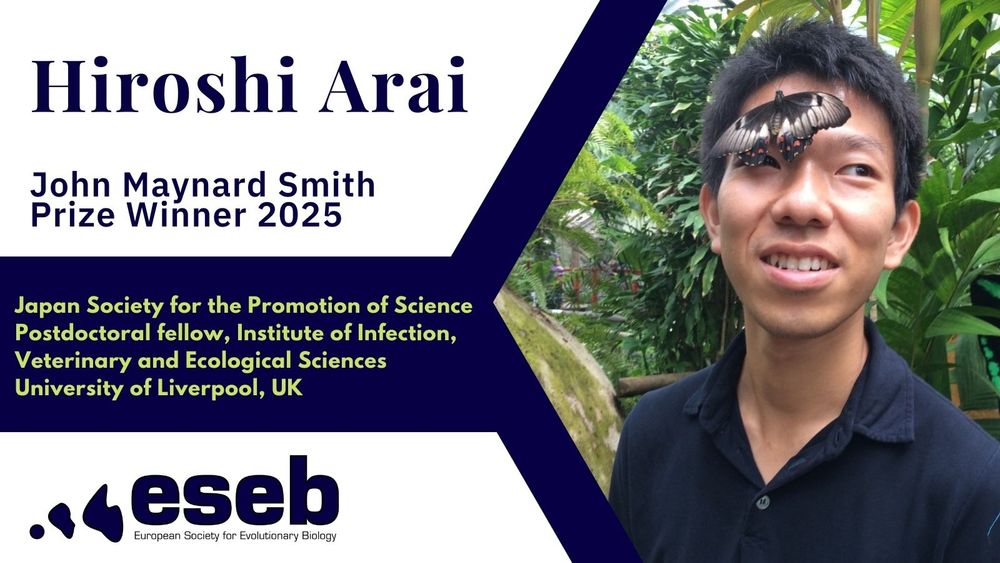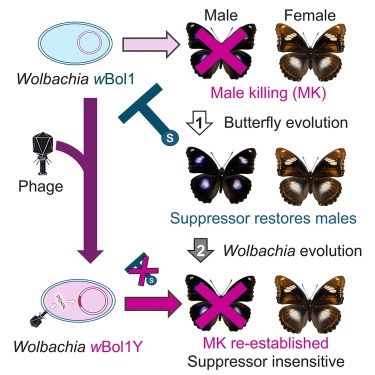
Beyond Wolbachia—Can a small molecule control insect reproduction?
Kaur et al. demonstrate reduced histone acetylation as a key mechanism underpinning
Wolbachia’s paternal-effect embryonic lethality trait in Drosophila melanogaster.
Recapitulation of this trait by in...
#Wolbachia has puzzled scientists with its power to rewire insect reproduction. What if I tell you that we found one of the keys Wolbachia use to rewire its host AND a small molecule inhibitor uses this key to mimic what this microbe has mastered for millions of years.
www.cell.com/cell-reports...
03.10.2025 12:57 — 👍 56 🔁 23 💬 2 📌 2

🌍🦋 Across 6 continents, 21 sites & 15,000 paper moths, we joined a worldwide experiment led by @wlallen.bsky.social & Iliana Medina, showing how ecological context shapes the evolution of animal colouration.
Proud to be part of this global team effort: doi.org/10.1126/scie...
25.09.2025 18:39 — 👍 84 🔁 26 💬 4 📌 3

A white-fronted bee-eater (Merops bullockoides) decides whether to consume a warningly colored white-barred acraea butterfly (Telchinia encedon). Photo (c) Mike Rowe
📢🦋 Our paper ‘Global selection on insect antipredator coloration’ is out and featured on the cover of @science.org
We ran a huge experiment to find out how ecological context favours camouflage and warning colouration as antipredator strategies. 1/6
www.science.org/doi/10.1126/...
25.09.2025 18:25 — 👍 132 🔁 52 💬 3 📌 6

Ecology and evolution of virulence
Silva and King discuss the concept of virulence and the ecological and evolutionary
factors that shape it.
Interested in #virulence? Not sure what it is - or how to explain it? Just curious? 🧐🦠🧬🦋
@kayla-king.bsky.social and I just wrote a Primer for @currentbiology.bsky.social on the ecology and evolution of virulence!
Check it below and share :)
#MicroSky #EvoSky #pathogens
22.09.2025 15:22 — 👍 60 🔁 26 💬 2 📌 0

Evolutionary Diversification and Functions of the Candidate Male Killing Gene wmk
Abstract. Symbiont-mediated male killing (MK) is a mechanism that selectively eliminates male offspring, often by disrupting sex-specific developmental pro
New accepted manuscript (preprint) on the evolution, phylogenetic types, expression, and fxns of a male-killing gene from a phage in a common endosymbiont of animals. Credit to many lab coauthors and led by Dr. Emilie Lefoulon. Lots of fun and insights in this one. academic.oup.com/gbe/advance-...
21.09.2025 23:59 — 👍 14 🔁 6 💬 2 📌 2

Striking diversity of male-killing symbionts and their mechanisms
Symbiosis is a fundamental characteristic of eukaryotic biology. Arthropods, including insects, often harbor maternally inherited endosymbiotic microb…
Our new review paper with @daisukekageyama.bsky.social is out in Trends in Genetics (@cp-trendsgenetics.bsky.social)!
We summarise the current knowledge on the diversity of male-killing microbes and their mechanisms.
Available here:
🔗 www.sciencedirect.com/science/arti...
11.09.2025 12:47 — 👍 10 🔁 5 💬 1 📌 0

Check our latest paper in @currentbiology.bsky.social about the unique sex determination system in Nautilus ➡️ XX/XY chromosomes unlike other cephalopods (ZZ/Z0).
with @reef-combo.bsky.social and @anariesgo.bsky.social et al., and led by Hector Torrado.
Get it: authors.elsevier.com/c/1lbs~_LsQS...
25.08.2025 12:25 — 👍 26 🔁 13 💬 2 📌 3
I had the pleasure of presenting on MK microbes at #ESEB2025 (JMS lecture) — many thanks to everyone who attended! I also learnt a lot from inspiring studies — thanks to all the speakers. On the way, I was fortunate to come across a beautiful book: 흰 (The White Book, Han Kang)
24.08.2025 09:13 — 👍 4 🔁 0 💬 0 📌 0
Recent achievements:
Our review paper on the striking diversity of male-killing (MK) symbionts and mechanisms has just been accepted in Trends in Genetics! I’m grateful to the reviewers for their thoughtful and valuable suggestions, and I look forward to sharing the article once it’s published
24.08.2025 09:13 — 👍 9 🔁 0 💬 1 📌 0
Our New Paper is out! Great work by Mashaneh Ahrar and the team - thank you all, especially @makaefer.bsky.social and Greg Hurst (is he on Bsky???)! TBC :)
30.04.2025 13:09 — 👍 9 🔁 5 💬 2 📌 0

A license to kill
Bacteria belonging to the Wolbachia family employ distinct genes to kill the male offspring of different insect species.
Wolbachia bacteria hijack insect reproduction by killing off males, but it turns out they don’t use the same weapon in every species. New research uncovers species-specific genes with a license to kill.
18.04.2025 10:02 — 👍 22 🔁 9 💬 1 📌 1
Thank you very much, Seth! (from Okinawa)
15.04.2025 14:13 — 👍 1 🔁 0 💬 1 📌 0
Redirecting
Very happy to receive two great news after the long flight : current biology (doi.org/10.1016/j.cu...) and JMS prize (eseb.org/prizes-fundi...)
10.04.2025 04:19 — 👍 5 🔁 0 💬 1 📌 0

This year's Runner-Up for the JMS Prize is Kaleda Denton!
Her research was highly commended by the Prize Committee and you can read more about her work here:
eseb.org/prizes-fundi...
09.04.2025 14:47 — 👍 6 🔁 3 💬 0 📌 0

⭐2025's John Maynard Smith Prize Winner is Hiroshi Arai⭐
Hiroshi will give the JMS Prize Lecture in Barcelona this August at #ESEB2025 @eseb2025.bsky.social
Read more about his prize-winning research here: eseb.org/prizes-fundi...
09.04.2025 14:44 — 👍 15 🔁 7 💬 0 📌 0

Evolution of Wolbachia male-killing mechanism within a host species
Male-killing bacterial symbionts, prevalent in arthropods, skew population sex ratios by selectively killing male progeny, profoundly impacting ecolog…
@haraipapilio.bsky.social paper on evolution of Wolbachia MK mechanism through prophage acquisition in molina butterflies - avoiding suppression by the host. Now out! #symbiosky www.sciencedirect.com/science/arti.... With @daisukekageyama.bsky.social @bolinabug.bsky.social and others
09.04.2025 15:45 — 👍 45 🔁 34 💬 1 📌 1
🏳️🌈 she/her
PhD candidate, PEARG, University of Melbourne. Studying plant-insect-microbes interactions for a more sustainable agriculture.
Experimental ecology and evolution | multicellularity | evolution of cooperation | medical microbiology | microscopy
Research Fellow at University of Helsinki
~ Evolution, genomics, lepidoptera, all things colour🦋
Evolution of structural color in butterflies🦋🌈 Reproductive functional evolution 🧬 Postdoc | UC Davis
🌐 sites.google.com/view/rachelcthayer/welcome
Virus evolution, ecology and host shifts. Fly zookeeper. Insect rhabdovirus geek. Tea Junkie. Like music, food, bikes. Lab website: www.benlongdon.com
Writing a book about horizontal gene transfer and non treelike evolution. Bioinformatics, Evolutionary Biology. Pangenomes. Chair in Evolutionary Biology. 🇮🇪 http://github.com/mol-evol/panGPT
Curious how toxins drive the evolution of new traits 🐸🦖🐍🧪
In awe of nature’s cleverness and strangeness
Enthusiastic champion of caterpillars 🐛
@mpi-ce @livuni-ives
hannahrowland.co.uk
Associate Professor in Evolutionary and Sensory Ecology - Swansea University, Wales www.easelab.uk
co-Director @crocus-dla.bsky.social
Senior Editor @ecol-evol.bsky.social
作家。『鴨川ランナー』、『開墾地』、『言葉のトランジット』(いずれも講談社)、『単語帳』(U-NEXT)、『トラジェクトリー』(文藝春秋)など。読売新聞、信濃毎日新聞にてエッセイ連載中。法政大学准教授。
Gregory Khezrnejat. Author, associate professor.
Microbes & mucus 🤩 | Gut Microbial Ecology | Wageningen University, NL
Conservation scientist @uq-cbcs.bsky.social committed to overcoming biases and barriers in conservation and science. See
http://translatesciences.com
http://kaizenconservation.com
he/him
A stunning Victorian building home to 7 million objects. Free entry, open 10-5 every day.
Population & comparative genomics, evolutionary biology & adaptation / Researcher at CEA Genoscope / ORCID: 0000-0003-1900-7715
Google Scholar: https://scholar.google.com/citations?user=1bs5bs4AAAAJ&hl=fr
Professor passionate about student success & team science #firstgen #Brassica enthusiast walking Dogs of the Plant World
#Agriculture #Food #HigherEd #EduSky #Agsky #SciComm & more
#Soil #Crop #Science ; opinions mine
Evolutionary biologist
Tübingen < Plön < Kiel < Sapporo < Tokyo
https://junishigohoka.github.io/
A platform for life sciences. Publications, research protocols, news, events, jobs and more. Sign up at https://www.lifescience.net.
EvoDevo, Sex determination, Haplodiploidy 🐜 🐝 🐞 and sex chromosomes🐡 🦎 Principal investigator @GenEvo RTG.
UNC-Chapel Hill 🇺🇸 -> MEME 🇪🇺-> INRAe 🇫🇷-> Uni Lausanne🇨🇭 > Institute of Molecular Biology, Mainz, Germany🇩🇪
A reviews journal from Cell Press that fosters an appreciation for advances being made on all fronts of genetic research.
Editor: Maria Smit
https://www.cell.com/trends/genetics/home
Professor of Ecology at the University of Helsinki
🧪 #Animal behaviour, #animal coloration, #evoeco, #moths, #sensory ecology #fundamental science
I teach birds to play computer games












